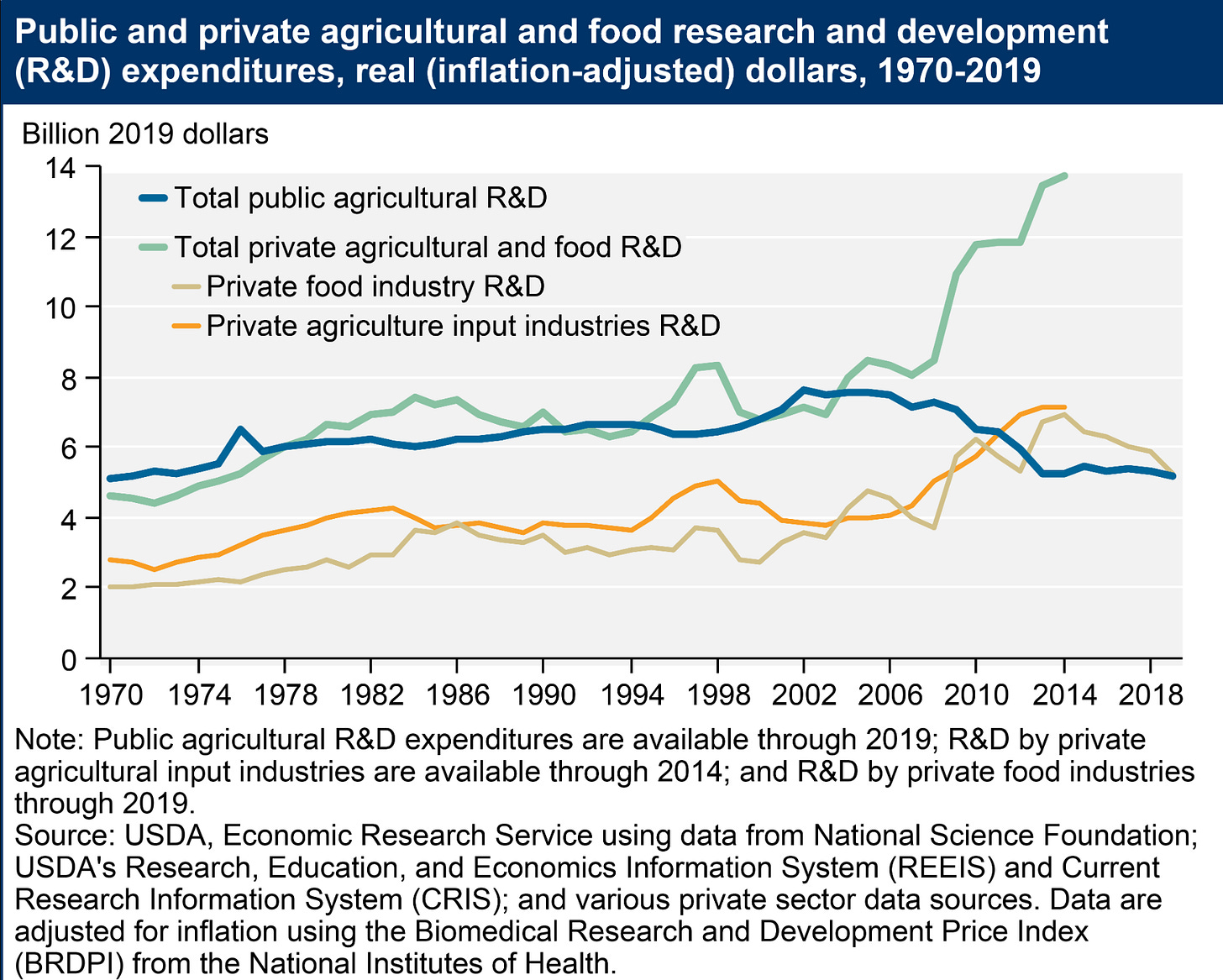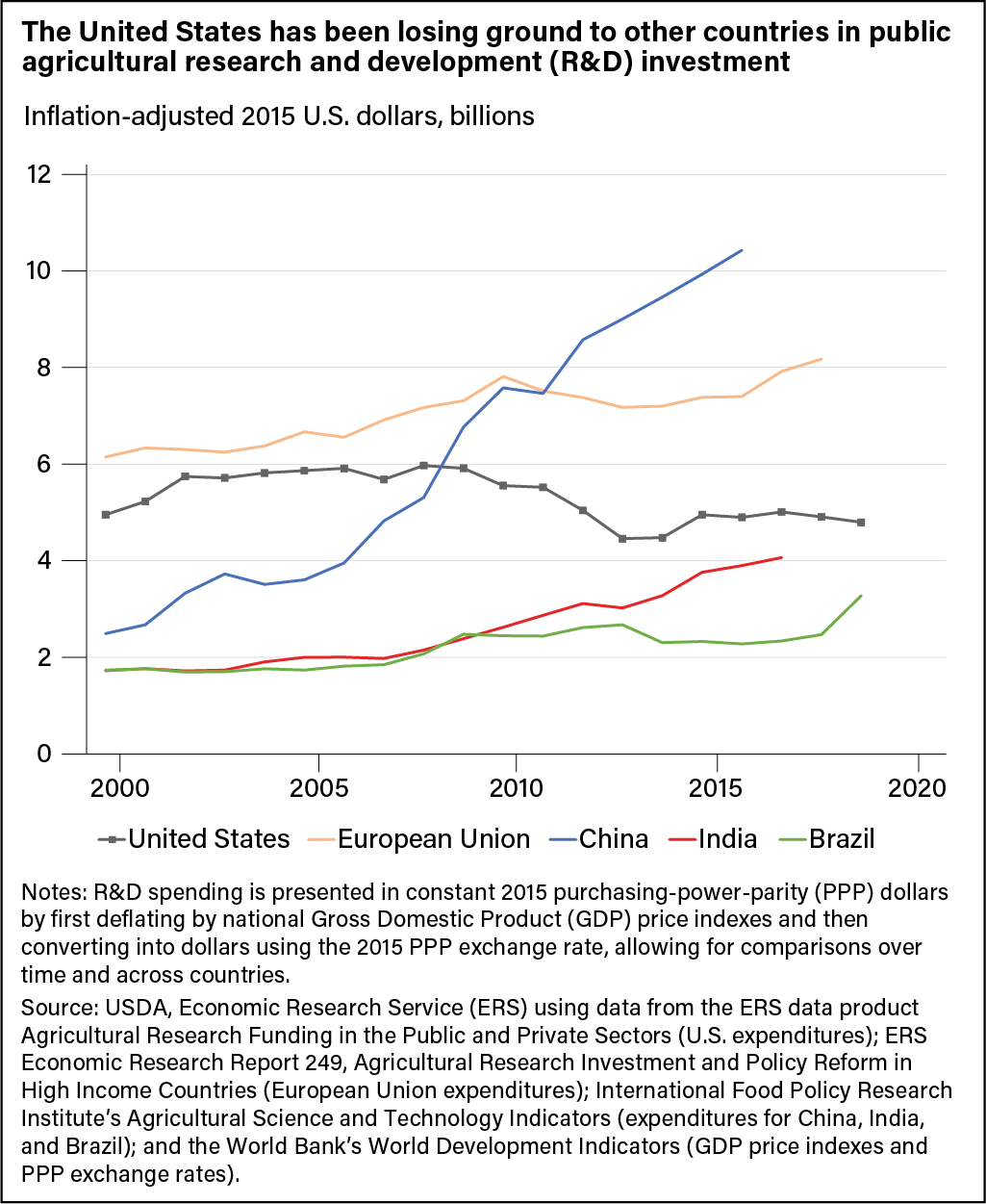
Welcome to Topsoil – a monthly newsletter with frameworks to help you make sense of agriculture, at just the right depth.
There is an invisible driving force that wordlessly fuels many everyday miracles in agriculture.
Mouth-wateringly crisp apples, in abundance. Tractors that plant seeds in an unwaveringly perfect line. A system that produces far more calories than 8 billion people can consume.
Research and Development (R&D) is that powerful force. Agricultural R&D is pretty much what it sounds like: systematic work to create and apply knowledge of plants, livestock, nutrition, food safety, agronomy, production systems, and natural resources.
To pull the curtain back on R&D and how it underpins agriculture, I wanted to speak with an expert. Dan Northrup has tackled R&D from many different angles throughout his career – from academia (he earned a PhD from University of Pennsylvania in immunology), to operating at a start-up (Benson Hill), to working with government research agencies (ARPA-E), to assisting investors (Galvanize Climate Solutions). Dan conducts research at Iowa State University (a Land Grant University).
Today, I’m excited to share what I learned about R&D in agriculture from Dan. (Side note: any quotes are from Dan unless otherwise noted).
Let’s dig in!
Do More With Less
Besides being the marketing tagline for pretty much every agriculture company right now, one of the biggest stories over the past several decades is that farmers are doing more with less. They are producing much more (in terms of yield) using less land and fewer inputs.
The fancy economist word for this more-with-less concept is called total factor productivity. R&D is one well-known way to increase total factor productivity. Whether tiny improvements that add up (evolutions) or new ideas that change the game (revolutions), R&D works as a kind of magic.
What do you do with an idea?
So how does a new idea eventually become something that can help farmers?
Dan walks through the process: “It starts with a hypothesis. You may have a modeling framework you can work in, sometimes called ‘in silica.’ You may be able to test this ‘in vitro,’ like an enzymatic assay that would let you evaluate a bunch of different proteins. You might move on to an ‘in vivo’ experiment that could be in the plant, the insect, the microbe – whatever organism it is that you are testing. Then you move to a greenhouse where you could have real soils but you have total control over the weather. And finally you get out into the field which is the key place where the product needs to perform.”
“In the end you have to get out there and demonstrate relevance to farmers. As the stages go along, you get a better and better sense of the value of the idea or product. You move from asking, ‘Does it work?’ to ‘What are the conditions where it works?’”
Throughout every step in product development, researchers balance two factors: relevance and control. They want to make the results as relevant as possible to the real world. However, they need to control as many variables as possible to observe and measure the actual phenomenon of interest.
You can think of this balance of relevance and control like this scatterplot below along the path to commercialization:
As ideas get closer to the field, relevance increases, but control decreases. In a computer model or a lab setting, variables can be perfectly controlled, but it’s a far cry from the messy, chaotic 3D world where agriculture takes place. Farmers trust localized field trials more than lab experiments because the relevance is higher, but experiments typically get more expensive as they move to the field. Wildcards like weather, soil type, and differences in equipment can make it difficult to interpret results and tease out real effects.
R&D funding: follow the money
Dan outlined the main sources of funding for R&D in agriculture:
-
Public: “You’ve got the public sector. For the US government this is housed in several agencies: Department of Agriculture (USDA), Department of Energy (DOE) because of biofuels, National Science Foundation (NSF), Agency for International Development (USAID), and to a smaller degree the National Institutes of Health (NIH).” In addition to Federal funding, state and local government agencies contribute to agriculture R&D. Beyond governments, commodity groups and checkoff programs fund farmer-guided commodity-focused research to improve production and develop markets.
-
Private: Private funding includes money from corporations and investors. Dan describes, “A large portion of industry research is focused on product development like acreage expansion with some budget dedicated to new products or stretch research.” Venture capital (VC) invests money in start-ups and ideas that may be outside of the mainstream, riskier, or take more time to develop.
-
Philanthropic / Non-Governmental Organizations (NGOs): Finally, there are several NGOs or non-profits that invest in agriculture R&D around the world and can attempt more “transformative types of interventions.” Dan explains how influential this source of funding can be: the Rockefeller Foundation sponsored the work of Norman Borlaug, who is credited with preventing hundreds of millions (!!!) of people from starving.
A Closer look at Public and Private
Since 2002, US public funding of agriculture R&D has declined by over 30%. This was even before the most recent cuts this year that have impacted nearly every agency that contributes to agriculture R&D.
While public funding of agriculture R&D has declined in the US, private R&D has increased:
No big deal, you may be thinking. Awesome that Bayer and Corteva and PepsiCo and Nestle are picking up the tab to the tune of billions of dollars each year. Why should taxpayers foot the bill anyways?
There are indeed good reasons why publicly funded R&D is critical for agriculture:
-
Public research for public goods and longer timelines: “Public research can benefit the greater good, whereas private companies may not undertake research if it doesn’t benefit that one specific company.” Dan shares an example: “There was a large public investment in soil stewardship after the Dust Bowl of the 1930’s. Some trends take decades to emerge, some of the longest running agricultural experiments are over 100 years old. There are lessons you can only learn by studying on timelines that are longer than the business cycle.”
-
Diversified funding sources are important: Many researchers including Naomi Oreskes and Marion Nestle highlight the ways that funders (public and private) influence the scientific process. Having multiple people approach the same question from different angles can reduce bias.
-
Building a skilled workforce: “Public R&D is a great training ground for young people. No one starts great at their job, and industry or startups don’t have time to provide on the job training. It’s an important feeding ground for industry.” Good science is a craft as much as it is something to be learned in a classroom.
-
Preparing for the unexpected: “Another reason is that you get surprised sometimes and the world changes and suddenly something that was off the commercial path is important.” An example Dan gave is that during the COVID pandemic, an effective vaccine was made quickly because years and years of fundamental research on mRNA had already been completed. “Revolutions [in agriculture] often come from people doing things that they think are interesting, before anyone understands exactly how they are going to make money.”
Outside of the US, countries like China and Brazil have drastically increased spending on public R&D for agriculture. China more than tripled investment in agriculture R&D since 2000, to over $ 10B in 2015 (roughly twice the amount that the US spent that year).
Adding to the challenge of shrinking public funding of agriculture R&D in the US, the efficiency of each dollar spent in agriculture R&D may be declining. Shane Thomas explains this well, called “Eroom’s Law.” Instead of productivity doubling every two years (like Moore’s law in computer chips), the time it takes to develop a new crop protection active ingredient has doubled over the last 20 years. This is to be expected after decades of harvesting the “low hanging fruit” of ideas.
The future of R&D
Despite tightened budgets, Dan says, “People need innovation.” And, he has ideas on how R&D can become more efficient and reach the farmers and consumers it benefits. Dan envisions a future where “every farm is an experiment station.”
Today, many farms already conduct small scale trials as they sample new products or practices to incorporate into their production system. A new product applied across one or a few fields. A test strip here or there. Trying out a new piece of equipment. In these cases, any discoveries are often kept private to that farm.
Dan believes that both relevance and control of any given R&D project could be vastly improved if more farms conducted on-farm trials and shared that data and research with other farmers and the companies and researchers developing new products and practices. And of course, farmers must be compensated for that effort.
With precision technology becoming widespread, farmers can be more scientific in their observations and more easily share consistent data. Beyond the equipment to apply inputs precisely, equipment like drones could take measurements throughout the season to make on-farm R&D cheaper and more widespread.
Not only would this help to advance agriculture R&D with improved products being developed faster, it also creates “a much more interesting way for growers to sell their data than today. It almost goes without saying that these datasets need to be created for agricultural R&D to benefit from the massive investments in artificial intelligence.”
Ultimately, Dan believes that beyond improving practices within any single farm, this new paradigm would mean that “farmers can drive innovation and encourage new entrants to invest in product development relevant to the farmer’s pressing challenges.” Dan is optimistic that agricultural R&D will continue its track record of success.
Topsoil is handcrafted just for you by Ariel Patton. A sincere thank you to Dan Northrup for debating ideas and sharing his knowledge. Complete sources can be found here. All views expressed and any errors in this newsletter are my own.
If Topsoil has helped you understand the fascinating world of agriculture a little better, please like using the heart button below, subscribe, or share with an ag-curious friend!


